Variety is the spice of Australian life
POSTED ON 24/05/2009A recent survey conducted by research group Wine Intelligence shows that wine drinkers haven’t much of a clue about New World wine regions. As against 94% awareness of Bordeaux in the UK and 80% in the US, followed by Champagne (93% UK; 75% US), only 10% of US respondents had heard of the Barossa Valley, and 12% of Marlborough in the survey, which polled 2,000 regular wine drinkers in the US and a 1,000 in the UK.
The survey also asked all 3,000 respondents to write down the first word they thought of when shown the name of a particular wine region. When Marlborough was shown, the most popular response from both groups was ‘cigarettes’, while Silence of the Lambs, the 1991 film, scored highly for Chianti. A separate Wine Intelligence survey of 1,000 UK wine drinkers however showed that they have more affinity with Australia and New Zealand, in terms of people and culture, than any other wine-producing country.
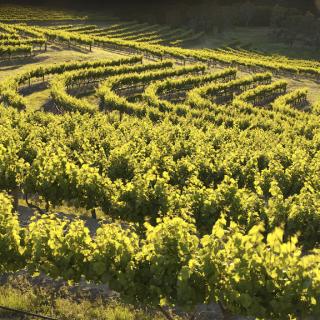 Eden Valley. Where? © Charmaine Grieger
Eden Valley. Where? © Charmaine Grieger
The latter at least is heartening news for Australia, which could do with it given that Australian wine has been much in the news lately for all the wrong reasons. Its reputation as a serious wine producing country has grown steadily since it burst on the scene in the 1980s, overtaking France in 2004 as our number one supplier of wine. But last year Australian wine exports fell for the first time in 15 years.
Why? Brands like Yellow Tail, Hardy’s Crest and deep-cut, buy-one-get-one-free promotions in supermarkets have done Oz no favours. Remember Rosemount? An object lesson in how to trash a brand. And Lindemans? Once a famous Hunter Valley and Coonawarra brand, now, you can buy Chilean Lindemans. Meanwhile Robert Parker’s excessive ratings of a handful of unknown cult shiraz like Three Rivers and Duck Muck have been counterproductive. Penfolds Grange apart, collectors have had their fingers burnt when they realized that such alcoholic monsters soon palled. And of course Oz has had its own serious domestic problems of heat, drought and forest fires.
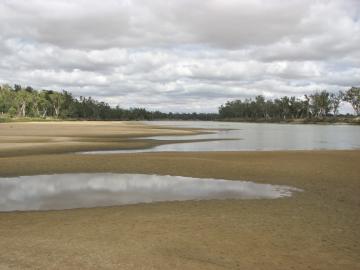 effects of drought: Murray River © Robert Grieger
effects of drought: Murray River © Robert Grieger
In the middle of all this, it would be easy to overlook the fact that despite water-shortage and over-supply issues, Australia is a country of diverse regions and wine styles with more than 2300 wine producers. There are 64 recognised wine regions in Australia, most of those in South Australia, Victoria, Western, South Australia and New South Wales. Among the 135 grape varieties used to produce varietal or blended wines, shiraz is the most common variety being produced with more than 80 per cent of producers making it, followed by cabernet sauvignon with 70 per cent and chardonnay with 69 per cent. 235 producers now make a straight or blended wine with tempranillo, up 19 per cent with other varietals to show growth including pinot gris, marsanne and colombard.
In this month’s Decanter masterclass, I decided to take a look at Australia’s exceptional quality and diversity by looking at a cross-section of the main regions and focusing on some of the things that Australia does best. Here is a summary:
1. The Sauvignon / Semillon ‘Graves-style’ blend
2008 VOYAGER SAUVIGNON BLANC SEMILLON
Justerini & Brooks, around £9.47
Voyager Estate is located in the southern part of the Margaret River region, just a few kilometres from the Indian ocean with Steve James as viticulturist and Cliff Royle, chief winemaker. The immaculate estate is designed in the Cape Dutch style so at first sight you might almost imagine yourself in South Africa’s winelands, but any similarity ends there. Voyager flies what’s believed to be the second biggest Aussie flag after the one in Canberra, hence the nickname ‘Viagra Estate’.
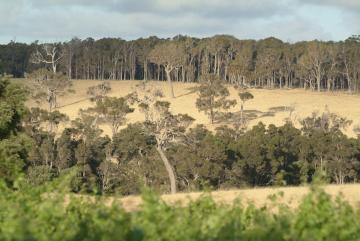 Margaret River © Charmaine Grieger
Margaret River © Charmaine Grieger
The website says: ‘Farming and agriculture have been the backbone of the Wright family since the 1850s and Voyager Estate’s owner, Michael Wright, believes that farming forms the moral fibre of his family. His passion for agriculture led him to create a super-premium wine brand, Voyager Estate. The original vineyard was purchased by the Wright family in 1991 but established in 1978’.
The 2008 ripening period was warm and dry. Combined with mild night-time temperatures, this resulted in one of the earliest starts to harvest seen at Voyager Estate, starting on the 18th of February. 2008 was an outstanding season for both sauvignon blanc and semillon. Voyager’s site says ‘The sauvignon blanc was machine-harvested at night, then crushed, cooled through a must chiller and pressed to tank. Fruit flavours are in the gooseberry, white peach and lychee spectrum, whilst the semillon as displays intense flavours of lemons and grapefruit, combined with the distinctly Southern Margaret River herbaceous edge’.
A blend of 55% sauvignon blanc and 45% Semillon (12.9% alc), this is youthful fresh and delicately scented, showing elements already of that classic, delicately herbal Graves-style combination of sauvignon blanc and Semillon; the fruit is already deliciously, palatably juicy and approachable, with opulent, full-flavoured melon, gooseberry and nectarine fruit, full, rich and rounded, but with a lovely citrus acidity cutting through that opulence like a switchblade. A classic in the making, with none of the hefty oak that can spoil Graves.
2. Hunter Semillon
1998 TYRRELLS WINEMAKERS SELECTION VAT 1 SEMILLON, HUNTER VALLEY, NSW
£19.99, Tesco has the 2000 (moving to the superb 2002), selected stores, also Waitrose, selected stores, Majestic, St Johns Wood, (has the 2002)
The website says: ‘2008 marks the 150th anniversary of our family’s arrival in Pokolbin to commence its future in the Australian wine industry. 150 years of one family with a constant base and industry in which it operates is a rarity in the country. The motto of ‘nothing is great unless it is good’ came with my (Bruce Tyrrell’s) great grandfather from England and has been a guiding beacon for the family through the 150 years.
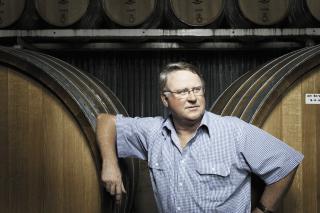 Bruce Tyrrell © Tyrrells
Bruce Tyrrell © Tyrrells
The introduction of Chardonnay and Pinot Noir to the modern Australian industry, our expansion outside our beloved Hunter Valley to McLaren Vale, Limestone Coast and Heathcote, and the championing of the Semillon variety from the Hunter are, to me, the outstanding achivements. Building upon an inheritance of just 60 acres to 900 acres today, premium vineyards extend from the Tyrrell’s legendary home in the Hunter Valley to other distinguished grape growing regions of Australia including Limestone Coast and McLaren Vale in South Australia and the Heathcote region in Victoria’.
The first vines of the 6.4 hectare Short Flat vineyard were planted in 1908. The vines grow on sandy well-drained soils with all the vines on their own roots. Drought conditions were experienced during the growing period followed by extreme heat in January and February. So 1998 was a short sharp vintage that produced ripe clean fruit of excellent quality with picking in the first week of February yielding 2.5 tonnes / acre.
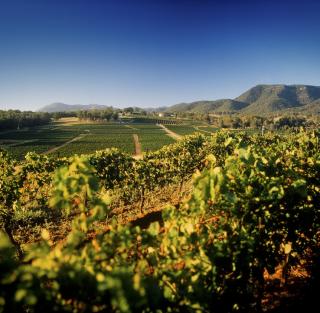 Tyrrell's Hunter Valley Vineyards © Tyrrells
Tyrrell's Hunter Valley Vineyards © Tyrrells
The fruit was crushed and fined before temperature controlled fermentation in stainless steel tanks. After fermentation, the wine spent minimal time on fine yeast lees before being prepared for an early bottling to retain the vibrant fresh fruit characters. The next six years (my italics) were then quietly spent in a dark, temperature and humidity controlled cellaring facility at the winery before being released and the wine was bottled on 10th June 1998 (under cork).
The thing to remember about this extraordinary wine is that it’s 11 years old, it’s unoaked and it’s 10.5 per cent alcohol. It’s yellow gold, showing some age, but not its age, if you see what I mean. It’s fresh but evolved at the same time, showing complex aromatic characters of farm buttered toast, lime and a hint of riesling-like petrol; it’s delicate on the palate, bone dry as an aged chablis (they used to call this style chablis and you can see why), with a light, citrusy finish. Not really fashionable perhaps because it lacks richness and power, but it makes up for it in elegance, character and freshness.
N.b It has received many awards including, as it has turned out, the only gold for an Australian Semillon at this year’s Decanter World Wine Awards.
3. Clare Valley Riesling.
2008 GROSSET POLISH HILL RIESLING, CLARE
RRP £19.95, Majestic Wine (fine wine stores/online), Winedirect, Wine Society, Noel Young Wines, The Sampler, Philglas & Swiggot, WoodWinters
According to his website, ‘Jeffrey Grosset’ s disciplined approach to winemaking involves meticulous attention at every stage, from the choice of the very earth itself, as in his selection of the famous windswept site for the Gaia, to the fine tuning during pressing and fermentation. He’s also been a fervent screwcap pioneer for whites and reds. But hand picking prevails exclusively in both his Clare Valley and Adelaide Hills vineyards. He was voted the Inaugural Volvo/ Wine Magazine Australian Winemaker of the Year and International Riesling Winemaker of the Year at the Riesling Summit II, Hamburg, both in 1998, to being listed as one of the fifty most influential winemakers in the world in Wine and Spirits, US, in 2005’.
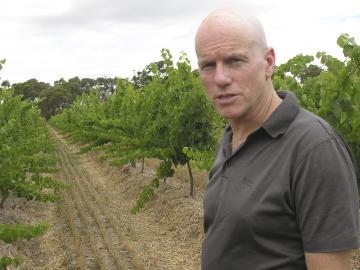 Jeffrey Grosset in his Polish Hill vineyard
Jeffrey Grosset in his Polish Hill vineyard
Jeff Grosset’s definition of terroir is interesting. At the inaugural New South Wales Wine Press Club lecture, he said: ‘Terroir is the French word for what some have known in Australia for thousands of years as 'pangkarra'. Pangkarra is an Aboriginal word … that represents a concept that has no English translation but encompasses the characteristics of a specific place – the climate, sunshine, rain, geology and the soil–water relations. About the closest we can get in English is to refer to “the site”, but even that doesn't cover the major components of terroir, or pangkarra, being the soil and local topography’.
‘The Polish Hill Riesling is a single site wine from the Polish Hill vineyard, planted at 460 metres above sea level on sandy loam over shallow clay with underlying gravel, shale and slate. It has been made each year since 1981. Situated in a U-shaped ridge formation running north from Mount Horrocks, the soil is shaley, not especially fertile, and slightly acid, and the topsoil crust is of clay and shale. In comparison to Springvale Riesling, Polish Hill is more austere, leaner, reflecting the nature of the terrain that Jeffrey Grosset, with his usual attention to geological constraints and possibilities, chose as his spot in the Polish Hill River area. Commercial vineyards first appeared in this sub-region during the 1890s, declined again until the 1970s and then came with a rush in the 1980s’.
Jeff Grosset thinks that the 2008 harvest has brought the best Polish Hill Riesling (13% alc.) since 2002. It’s certainly youthful and tight still and yet the aromas, understated yet with their distinctive hints of lime, are already intense and refreshing. The palate is refreshingly crisp and bone dry with intensely zesty lime and lemon notes and the minerality and power indicates that this wine, with its fine balance, will age beautifully.
4. Chardonnay
2006 CULLEN KEVIN JOHN CHARDONNAY, MARGARET RIVER
RRP: £35.93 per bottle, Fortnum & Mason, Stainton Wines, The Secret Cellar, Noel Young Wines, Oz Wines, Villeneuve Wines
Margaret River has been nicely described as ‘Peace and tranquility in a delightful and peculiarly Australian rural setting; a land of little creeks winding through gentle valleys with an abundance of indigenous shrubs, wildflowers and ancient contorted eucalypts. This is not the outback, there are innumerable restaurants - many operated by wineries - motels, vineyard cottages and cosy bed and breakfast hideaways; hotels too…’
Diana and Dr Kevin Cullen arrived in Busselton from Tasmania in 1948, purchasing land in the Margaret River region for farming purposes. Climatic studies carried out by the WA agronomist Dr. John Gladstones in the early 1960s showed that Margaret River could be ideal for the production of quality wine. Kevin and Di planted a trial acre of vines in 1966 and were sufficiently encouraged to plant 18 acres of vines on their sheep and cattle farm in 1971.
 Cullen vineyards© Charmaine Grieger
Cullen vineyards© Charmaine Grieger
After graduating from wine science at Roseworthy College, Vanya, their daughter, became senior winemaker, going on, in 2000, to become the Qantas/The Wine Magazine Winemaker of the year. In 2003, Cullen became organic and in 2004 biodynamic. A combination of a maritime climate, rocky old, granite and gravely sandy loam soils, dry farming, and biodynamic practices help to create the Cullen style. The chardonnay is on vertical shoot positioned trellis. 28 hectares are currently planted with 7.43ha of chardonnay.
Vanya says ‘biodynamics, which involves adopting a collective approach to working with the soil, the plants and the cosmos, has two underlying philosophies. The first recognises that it is important to maintain sustainable soil fertility, as is also the case with organic farming, while the second takes into account the link that exists between plant growth and the rhythms of the cosmos. The adoption of these philosophies in concert, results in the production of healthier plants and livestock. Cullen Wines are harvesting as much as possible using Maria Thun theory. She suggests that the moon in a constellation has a favourable influence on the elemental relationship of fire which makes it better for harvest giving greater intensity and preservation of fruit flavour’.
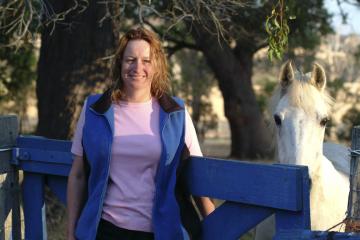 Vanya Cullen and friend, Bo © Charmaine Grieger
Vanya Cullen and friend, Bo © Charmaine Grieger
For the chardonnay, the bunches are whole-bunch pressed for fruit delicacy and juice quality and then placed into barriques for fermentation with indigenous yeasts. Practices such as hand harvesting, very little fruit transport, sorting of the fruit before crushing, minimal wine movement, minimal fining and filtration are used.
The exceptionally cool weather in the summer of 2006 led to the latest harvest of chardonnay recorded at Cullen Wines. The cool ripening conditions produced elegant and powerful chardonnay fruit with great natural acidity and led to yields 50% below that of a typical vintage at Cullen Wines. Golden straw with green tinges, it’s aromatically complex with notes of pineapple, honey, vanilla oak and grilled nuts, while the palate shows a richness and purity of melon and tropical citrus fruits allied to excellent acidity and intense mineral characters.
5. Viognier.
2007 YALUMBA THE VIRGILIUS, VIOGNIER, EDEN VALLEY, SOUTH AUSTRALIA
RRP - 23.20, Waitrose (selected fine wine stores) , Majestic ( selected fine wine stores) , Premier Vintners , Le Pont de la Tour Wine
According to the website, ‘Yalumba 'The Virgilius' Eden Valley Viognier is one of Yalumba's most distinguished white wines and our premium Viognier offering. With more than 26 years of experience with this variety, Yalumba today is one of the most influential producers of viognier in the world’.
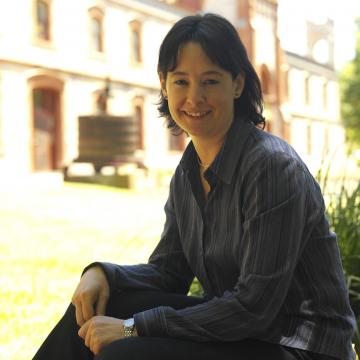 Louisa Rose © Charmaine Grieger
Louisa Rose © Charmaine Grieger
Made by Louisa Rose, hand picked grapes were whole-bunch pressed directly to barrels, and the juice handled ‘with passive oxidation’. The wine was fermented mostly in mature French oak barriques, by a population of naturally occurring and differing species of wild yeasts. ‘The yeasts played a part in the development of the wine to produce layers of richness, complexity, texture and flavour’. After fermentation the wine was aged on lees with regular batonnage for 10 months.
The 2007 vintage followed an extremely dry growing season with natural rainfall in the Eden Valley during the season less than 40% of average and slightly higher than average temperatures.
This is the Yalumba’s top of the range viognier from South Australia’s Eden Valley, also the place from which it’s best rieslings come because it’s off the valley floor and cooler. The richest of Yalumba’s viogniers, it’s barrel-fermented, but lightly, so as not to interfere with the floral spicy aromas; and you can feel the richness and power (14.5% alcohol) of the concentrated peach-like fruit, a subtle touch of toasty oak, and perhaps a slight astringent twist of bitterness at the back of the palate, very much a viogner trait.
6. Fizz
2002 HARDY’S ARRAS CHARDONNAY PINOT NOIR, TASMANIA
RRP £29.99, Wimbledon Wine Cellars - www.wimbledonwinecellar.com (0208 5409979), Planet of the Grapes - www.planetofthegrapes.co.uk (0207 4054912)
Tasmania, the Ireland of Australia, is uncharacteristically green (for Australia), an island with a maritime climate of cooling oceanic breezes and consequently flavours defined by purity, natural acidity and freshness. Not surprisingly then, it’s the perfect source of grapes for sparkling wine, producing base wines of excellent natural acidity and low-yielding concentration. Ed Carr is Hardy’s sparkling winemakers and although Hardy’s has its own base, Bay of Fires, on Tasmania, Carr ships the raw materials back to South Australia where he makes Arras at Hardy’s HQ.
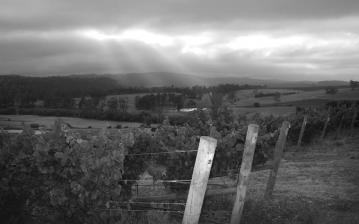 Arras vineyards, Tasmania © Hardy's
Arras vineyards, Tasmania © Hardy's
The blend is chardonnay 59.3%, pinot noir 40.7% with 98.9% premium Tasmania fruit, 82.4% from Glenora and the rest from the Pipers River and other regions. The grapes were hand picked and whole bunch pressed. Individual batches were fermented, clarified and blended with extended maturation on yeast lees. 2002 was a generally cool year with crop yields reduced by cold and wet weather during flowering in early summer. The cool weather delayed harvest, but there was a long Indian summer of dry and sunny conditions in mid Autumn.
Arras is intensely flavoured with brioche and yeast aromas, a persistent mousse and flavours of citrus with floral undertones. Both elegant and powerful, it displays the complexity of lengthy autolysis with a lively freshness and the capacity to age further.
7. Pinot Noir
2007 WILLIAM DOWNIE PINOT NOIR, YV, VICTORIA
RRP: £36.95 per bottle, The VineYard, Selfridges, Noel Young Wines, House of Menzies
William Downie says:
‘William Downie established his own label in 2003 after several years living and working in Burgundy. His intention is to produce wines of purity and detail that reflect their place of origin. They are made in the most natural way possible, not pushed or shoved in any direction. They are not added to or subtracted from. Although each of the William Downie wines is made from Pinot Noir, the Yarra Valley, Mornington Peninsula and Gippsland are more different than they are similar. William was the Gourmet Traveller Wine Magazine Young Australian Winemaker of The Year for 2006.
I make only Pinot Noir but from 3 regions, Yarra Valley, Mornington Peninsula and Gippsland (Leongatha). All of the current wines are from vineyards that are not owned by us but managed under our direction. We have planted a small vineyard at our farm in (Yarragon) Gippsland. It's planted at 11,000 vines/hectare and worked according to the (Organic) principles of Elaine Ingham and the Soil Food Web Institute. A large part of the establishment was done using a team of Clydesdales which we will continue to use as much as possible. We still have a lot to learn!!!’
I cut my teeth working vineyards and cellars in Gippsland and the Yarra Valley before I moved to burgundy in 2001. I work '01 harvest through to '02 at Domaine Fourrier in Gevrey and then '03 to '05 at Hubert Lignier in Morey St Denis. After the unfortunate passing of Romain Lignier in July '04 I took over the winemaking for both the '04 and '05 harvests. In between time I worked harvest each year at De Bortoli in the Yarra and also set up and ran their Burgundy project from '03 to '05. I met my partner Rachel in Burgundy (she was working for Kermit Lynch) and we set up the William Downie label together in 2003’.
All their vineyards are hand harvested into 10kg cases and transported directly to the winery where the fruit is hand sorted and destemmed before being transferred to the fermenters. The whole process uses gravity. They do not inoculate with yeast or use any temperature control. The wines are aged without racking for one year before gravity bottling without fining or filtration.
The Yarra Valley Pinot Noir is made from 20 year old vines at Denton View Hill which has soils of grey clay loam over granite. In 2007 severe frost severely reduced yields. The remainder of the season was warm and dry with very little rain. The fruit was grown naturally using organic principles. Bright red in colour, it’s classic Yarra, with spicy aromas of youthful plum and raspberry and a lovely seductively spicy red-fruited palate tinged with light vanilla oak spice, finishing with a sheen of silky tannins.
8. Cabernet Sauvignon
2004 MOSS WOOD CABERNET SAUVIGNON
Around £45.00Jeroboams, The Wine Society
In 1984 Keith and Clare Mugford bought Moss Wood from Bill and Sandra Pannell Pannell, who started Moss Wood in 1970. The 19 hectare property at Wilyabrup originally produced just four wines, cabernet sauvignon, semillon, chardonnay and pinot noir, but now has 10 wines - seven from vineyards the Mugfords own, the rest from other vineyards. At latitude 34 degrees south, Margaret River has a maritime climate with consistent summer sea breeze maintaining a relatively high humidity.
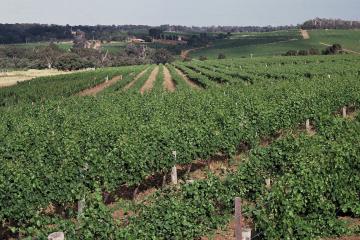 Moss Wood Vineyards © Moss Wood
Moss Wood Vineyards © Moss Wood
‘The Moss Wood estate cabernet style is fleshy, concentrated but smooth with supple, fully ripe tannins. Key flavours are cassis, coffee bean and tobacco, sending cigar boxy with a little age. It seldom has any of the herbaceous characters common to the region. Ask why and Keith humbly replies that the vines are unirrigated and the soils are such that the vines are sustained, even through the region's typically dry summers. Yields are low, averaging 8.5 tonnes per hectare. It's the site. In other words terroir’.
The 11.78 hectare vineyard Moss Wood vineyard at Wilyabrup is situated on a gentle north-east facing slope, where the soils vary from sandy loam to a gravelly, red-brown loam, over a clay subsoil. Mugford continues to improve viticultural techniques by reducing the density of the foliage and exposing the grapes to more sunlight.
In 2004, after a season of good rainfall following excellent flowering conditions, and with good bunch weights and yields, the fruit for the Moss Wood 2004 Cabernet was hand picked, destemmed into open tanks, hand plunged four times a day until dryness, after which it was plunged twice a day and monitored for tannin extraction. Typically, Moss Wood Cabernet is left on skins for ten to 14 days post fermentation: the 2004 averaged 14 days.
Including a small amount of cabernet franc and petit verdot, the wine displays typical mulberry and cassis aromas with oaky coffee bean undertones, lovely seductive dark cherry fruit on the palate with smoky oak, balance, excellent depth of flavour and length.
Should happily age in bottle for another five to 10 years.
9. Shiraz Viognier
CLONAKILLA, SHIRAZ VIOGNIER 2006
RRP: £34.39, Philglas & Swiggot, House of Menzies
I’ll let Tim Kirk speak for himself:
‘Clonakilla literally means ‘meadow of the church’ and is the name of the founder’s grandfather’s farm in County Clare, Ireland. Dr John Kirk founded Clonakilla vineyard at Murrumbateman, 40 kilometres north of Canberra in 1971. In 1997 Tim Kirk, the fourth of John’s six sons, took over responsibility for winemaking and general management.
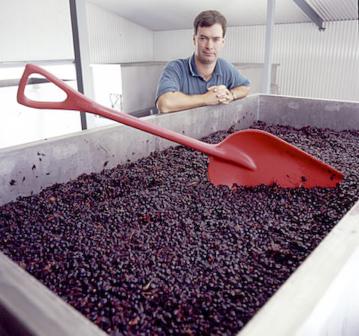 Tim Kirk © Clonakilla
Tim Kirk © Clonakilla
Canberra is fast becoming recognised for its cluster of twenty or so fast improving small wineries dotted about this higher altitude region of New South Wales. Clonakilla is the leading estate in the region. The fruit comes from two adjacent, family-owned vineyards just outside the village of Murrumbateman in the cool Southern Tablelands of New South Wales. ‘Canberra District’ is the official geographical indicator. This is the name given to the winegrowing district around Canberra, Australia’s national capital.
2006 was a textbook vintage: excellent spring rains followed by a warm summer and a mild, dry autumn delivered good crops of beautifully ripe fruit. Winemaking included a three day pre-ferment maceration, 20% whole bunches, extended warm open ferments (two to three weeks on skins) and twelve months maturation in French oak, 38% new. The 2006 includes 6% co-fermented viognier.
Pre-fermentation maceration lasted 3-4 days, with 17% whole bunches. The viognier was fermented with the shiraz and fermentation temperatures reached 34°C. The wine spent a total of 13-21 days on the skins, followed by 12 months in French oak, of which 38% was new and the rest a combination of one, two and three year old barrels. The oak was all French and the coopers included Francois Frères, Sirugue, Mercurey and Taransaud. The wine was bottled in late spring 2007’.
‘Excellent spring rains led to a warm summer and mild, dry autumn 2006, providing all the components for a top vintage. Tremendous depth of red/black colour, the viognier adds a rose petal lift to the perfume and a touch of softness on the palate. With less viognier than previous vintages, the 2006 gives full rein to the power and spice of the ripe, rich shiraz fruit and structure. Lush and velvety on the palate, with plenty of dark cherry and black pepper which follows through to the long, spicy finish’.
‘Our fifteenth Shiraz Viognier has a core of ripe fruit displaying layered spices, red fruits, dark cherries, black pepper and violets. Medium bodied and finely textured, the palate shows classic cool-climate structure with a supple, silken mouthfeel. It will reward careful cellaring for at least five to ten years’.
Thanks Tim, that sums it up nicely although I’m very happy to drink I now.
10. Shiraz
2002 PENFOLDS RWT SHIRAZ, BAROSSA
£34.77 - £46.50, Telegraph Wines, Averys, Harrods
According to Aussie journalist Max Allen. ‘The fact is, Australian winemakers have moved on since the 1950s. Today, more and more value is being placed on wines from single vineyards – wines that express the unique terroir of where they were grown – rather than multi-vineyard or multi-region blends such as Grange. Grape growers are exploring a whole new range of varieties other than shiraz, in dozens of up-and-coming regions cooler than the Barossa. And most winemakers have moved away from barrel-fermenting their reds in new American oak, preferring the more refined characters imparted by French oak, or the even-more-subtle influence of older and larger barrels.
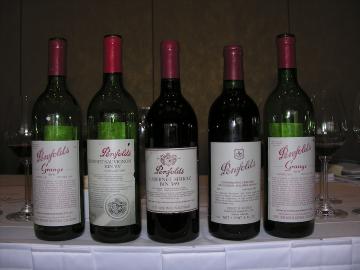 Penfolds wines
Penfolds wines
The well-travelled Peter Gago is acutely aware of these developments and, for the past 15 years or so, he’s made sure that Penfolds has broadened its winemaking horizons at the top end of the quality pyramid. Penfolds whites are thrillingly cutting-edge: the Bin 311 chardonnay from the cold NSW region of Tumbarumba is as lean and elegant and refined as any new-wave chardonnay from boutique producers in the Yarra Valley or Adelaide Hills; the French oak-matured RWT Shiraz is as fleshy and opulent and plush as any cult Barossa shiraz…’
A neat summary with which Peter Gago would not disagree. As he says himself, ‘Penfolds RWT Shiraz presents an admirable alternative to the multi-regional sourcing and American oak maturation that are hallmarks of Grange, expressing instead, single-region Barossa Valley Shiraz matured in French oak barriques. The initials RWT stand for ‘Red Winemaking Trial’, the name given to the project internally when developmental work began in 1995. RWT Shiraz was launched in May 2000 with the 1997 vintage.
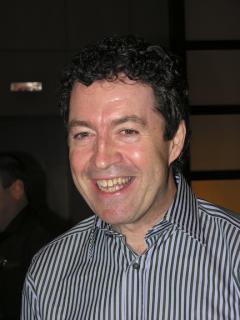 The indefatigable Peter G
The indefatigable Peter G
RWT draws fruit from 20 to 100 year-old vineyards arcing across the west and north-west of the Barossa Valley, mostly independently grown. Its style is opulent and fleshy, contrasting with Grange, which is more muscular and assertive. RWT is made from fruit primarily selected for its aromatic qualities and fine texture rather than sheer intensity or power of flavour. The result is a wine that helps to redefine Barossa shiraz at the highest quality level’.
In 2004, following regular winter rainfalls ensuring ideal soil moisture levels and healthy vine growth, spring and summer temperatures were amongst the lowest on record, which reduced yield potential, as well as slowing overall crop ripening to a crawl. A warm, dry autumn, combined with careful vineyard management, enabled the grapes to reach ideal ripeness. This wine was matured for 14 months in 66% new and 34% one year old French oak hogsheads.
The aromas are distinctly Barossa with undertones of chocolate, blueberry and liquorice spice. The palate is rich and opulent, almost lusciously full-flavoured with plenty of dark fruits, spice and chocolate, and the sort of concentration, structure and youthfulness that indicates a long life of a good 10 years ahead of it. It’s mighty impressive without being overdone.
11. Botrytis Sweet
2006 DE BORTOLI NOBLE ONE SEMILLON, RIVERINA
Around £12.99, half-bottle, Majestic Wine Warehouses, Waitrose, General Wine Company Ltd, Liphook (01428 722201), Wines Of Distinction, Battersea (07939 717 560), The Vintage House, London (0207 4372592), Beaconsfield Wine Cellars (01494 675545), Hailsham Cellars, Hailsham, East Sussex (01323 441212), Topsham Wines Ltd, Exeter (01392 874501), Frank Stainton Wines Ltd, Kendal, Cumbria (01539 731886), N D John Wine Merchants, Swansea (01792 644688), The Winesmith, Nassington, Peterborough (01780 783102)
De Bortoli Wines is a third generation family wine company established by Vittorio and Giuseppina De Bortoli in 1928. The couple emigrated to Australia from Northern Italy and bought a 55-acre mixed fruit salad farm in Bilbul near Griffith, NSW, in 1927. Their son, Deen De Bortoli, (1936 – 2003) expanded and consolidated the business created by his parents. Deen’s children in turn established De Bortoli's reputation for premium wine including icon dessert wine Noble One and the Yarra Valley wines.
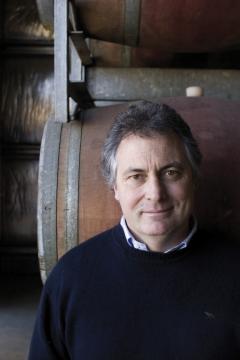 De Bortoli's Steve Webber © De Bortoli
De Bortoli's Steve Webber © De Bortoli
During the 1980s Deen and his son Darren, a fan of Sauternes who recognised the potential to make a dessert wine from grapes affected by botrytis cinerea or ‘Noble Rot’, made a sweet white wine from botrytised Semillon: Noble One. The Riverina enjoys a warm Mediterranean climate with winter dominant rainfall. The sandy loam soils vary in colour from red sandy earths to brown clay loams. 2006 was dry with very little rain until May, although early morning dews in late April allowed the onset of botrytis. Each vineyard was selectively hand picked separately to gain maximum botrytis flavours in the finished wine.
Selected vineyards are regularly assessed to determine the optimum harvest time for each parcel of fruit based on sugar content and the degree of botrytis. Each vineyard is harvested and fermented separately at 13º - 15º C. Fermentation can take from 3 weeks to 3 months. When fermentation is completed, the wines are clarified, stabilised and filtered to either barrel or tank. Most of the parcels are matured in French oak, 22% in new and 57% in one year old oak for 10 – 12 months with the remaining 21% left unoaked.
Bright, light gold, and only 10% alcohol, this is superbly aromatic with scents of peach, and nectarine along with hints of sweet vanilla from The palate oozes luscious rich nectariney fruit and spicy oak with lovely honeyed flavours and tangy citrusy acidity balancing the whole enterprise. Quite gorgeously irresistible stuff.
12. Fortified
BULLER CALLIOPE RARE TOKAY, RUTHERGLEN
£35, half-bottle, Majestic Fine Wine
‘On the gently undulating country around the township of Rutherglen in North East Victoria, in the south east corner of the Australia, brown muscat (or muscat a petit grains Rouge) and Tokay (muscadelle) grapes ripen into raisined berries high in natural sugars. The vignerons draw on a diverse range of vineyards across the district – taking young, fruity material from ten-year-old muscat vines, or mellow fruit from low-yielding dryland vines of 40, 60, or even 80 years old, to bolster their blends with muscat of exactly the required richness for each.
 Buller's Calliope © Buller
Buller's Calliope © Buller
The Rutherglen vignerons have learned how to extract the best from their muscat grapes, picking one block of vines early, or managing the yields of another through the use of selective pruning, or leaving another block of vines to mature long into autumn to gain maximum sugar and flavor. The vignerons must leave the grapes to desiccate on the vine for as long as possible – risking spoilage by early autumn rains’.
Andrew Buller says:
‘This wine is a stablemate to the Rutherglen Rare Liqueur Muscat but made from a different grape. The variety used is Muscadelle, for which Australia has adopted the synonym 'Tokay'. I am grateful to my father and grandfather who had the foresight to put down blending stocks of the best vintages of past years. This wine is aged in cask at the winery prior to bottling and will not improve with further cellaring.
Andrew Buller was born in Rutherglen, the youngest of three sons. Graduating from Roseworthy College in 1981, he gained valuable work experience at Corbans in Gisborne, NZ and by working harvests at the Leasingham Wine Company. His first success came early with a gold medal at the Rutherglen Wine show for his Vintage Port. Not letting early success go to his head, he continued to gain valuable experience throughout the 1980’s by traveling Europe between vintages at Rutherglen. He has worked four vintages with Taylors in Portugal, the famous Port producer, and one in Beaujolais, in addition to visiting the wine regions of Spain, France and Germany.
Today Andrew is winemaker/manager of RL Buller & Son’s Rutherglen vineyard and winery operation. He is a member of the Winemaker’s of Rutherglen, the Rutherglen Muscat Network, the Rutherglen export group and the Vignerons Association. Since 1921, the Buller family has produced heavyweight Muscats from their “Calliope” Vineyard - using the age-old techniques of basket presses and open fermenters to make the Muscats they call their "sleeping giant". Found 4km east of Rutherglen, this non-irrigated vineyard is 32 Ha and is the source of the most premium Muscat’s and Tokay’s from RL Buller.
The vineyard, situated 450 feet above sea-level, has a hot climate, continental, very sunny, moderately arid with little humidity. An average rainfall of 583 m, just over 3/4 of which falls between April and September. Temperatures range from 10 degrees C - 35 degrees C with mean January temperature of 22.7ĪC. The alluvial flats with gentle slopes and hard red duplex overlaying yellow-grey clay are typical of the Rutherglen region’.
This nut brown fortified ‘sticky’ is quite gorgeous. It’s viscously rich and concentrated with aromas of demerara sugar and molasses and it comes at you like something of a cross between an aged Malmsey Madeira and a PX, i.e. full of concentrated prunes, spice and chocolatey-lusciousness, yet with the saving balancing grace of a nutty, aged rancio effect and searing acidity. A magnificent, utterly unique Australian treasure.

